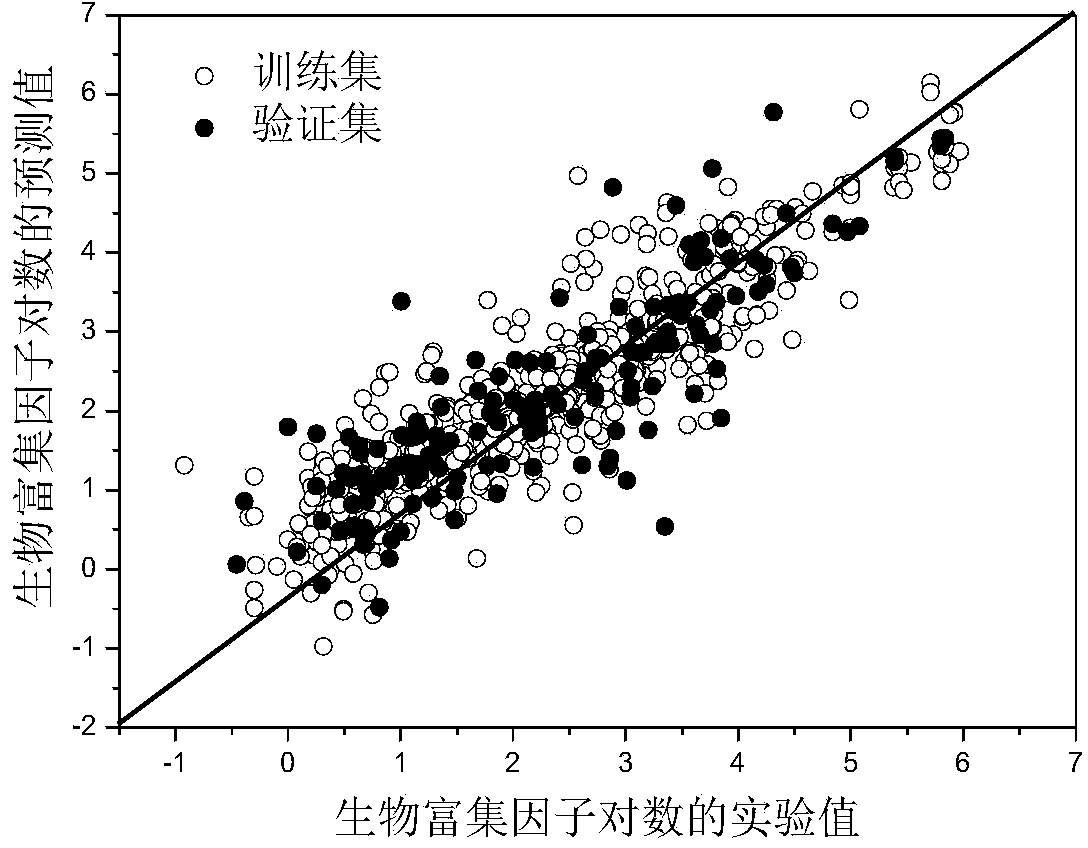Method for predicting fish bio-concentration factors of organic chemicals by quantitative structure-activity relationship
A technology for organic chemicals and biological enrichment, applied in special data processing applications, instruments, electrical digital data processing, etc. The effect of cohesion and shortcut data support
- Summary
- Abstract
- Description
- Claims
- Application Information
AI Technical Summary
Problems solved by technology
Method used
Image
Examples
Embodiment 1
[0026] Compound 1,2,3,6,7,8-hexachlorodibenzo-p-dioxin (CAS No. 57653-85-7) was randomly given, and its bioconcentration factor was predicted. First optimize the molecular structure of 1,2,3,6,7,8-hexachlorodibenzo-p-dioxin, and then calculate 12 descriptors MLOGP2, FO2[C-Cl] based on the optimized molecular structure , the values of nROH, P-117, Mor25m, N%, X4v, O-058, LLS_01, H4v, SM12_AEA(dm), O-057 are 20.902, 12, 0, 0, 1.239, 0, 2.907, 0 , 0.67, 0.24, 8.004, 0. According to the formula (2), the Euclidean distance of the eigenvector is 0.514 (<1.438). Within the scope of the model application domain, this model can be used to predict 1,2,3,6,7,8-hexachlorobiphenyl And - for - the bioaccumulation factor of dioxin, the value of logBCF is 3.926 when the descriptor value is substituted into the built model, and the experimental value is 3.927, and the prediction result is good.
Embodiment 2
[0028] The compound bisphenol A (CAS No. 80-05-7) was randomly given, and its bioconcentration factor was predicted. First optimize the molecular structure of bisphenol A, and then based on the optimized molecular structure, calculate 12 kinds of descriptors MLOGP2, FO2[C-Cl], nROH, P-117, Mor25m, N%, X4v, O-058, LLS_01, The values of H4v, SM12_AEA(dm), and O-057 are 10.928, 0, 0, 0, 0.375, 0, 1.923, 0, 0.83, 0.285, 6.164, and 2, respectively. According to the formula (2), the Euclidean distance of the eigenvector is 0.645 (<1.438). Within the scope of the model application domain, the model can be used to predict the bioconcentration factor of bisphenol A, and the descriptor value can be substituted into the established The model has a logBCF value of 1.639, of which the experimental value is 1.641, and the prediction result is good.
Embodiment 3
[0030] The compound 2,4,6-trichloroaniline (CAS No. 634-93-5) was randomly given, and its bioaccumulation factor was predicted. First optimize the molecular structure of 2,4,6-trichloroaniline, and then based on the optimized molecular structure, calculate 12 kinds of descriptors MLOGP2, FO2[C-Cl], nROH, P-117, Mor25m, N%, X4v, The values of O-058, LLS_01, H4v, SM12_AEA(dm), and O-057 are 10.982, 6, 0, 0, 0.191, 7.1, 1.37, 0, 0.83, 0.077, 5.225, and 0, respectively. According to the formula (2), the Euclidean distance of the eigenvector is 0.267 (<1.438). Within the scope of the model application domain, this model can be used to predict the bioaccumulation factor of 2,4,6-trichloroaniline, which will Substituting the descriptor value into the built model has a logBCF value of 2.133, of which the experimental value is 2.001, and the prediction result is good.
PUM
 Login to View More
Login to View More Abstract
Description
Claims
Application Information
 Login to View More
Login to View More - R&D
- Intellectual Property
- Life Sciences
- Materials
- Tech Scout
- Unparalleled Data Quality
- Higher Quality Content
- 60% Fewer Hallucinations
Browse by: Latest US Patents, China's latest patents, Technical Efficacy Thesaurus, Application Domain, Technology Topic, Popular Technical Reports.
© 2025 PatSnap. All rights reserved.Legal|Privacy policy|Modern Slavery Act Transparency Statement|Sitemap|About US| Contact US: help@patsnap.com



